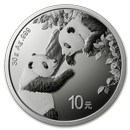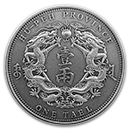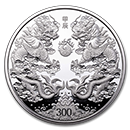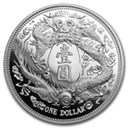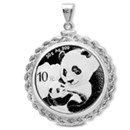
About Chinese Mint Silver
Chinese Mint silver coins are typically issued by the People's Bank of China (PBOC) or authorized state-owned mints such as the China Gold Coin Corporation. Chinese Mint silver is known for its high quality, artistic designs, and limited mintage, which makes it attractive to both collectors and investors.The Chinese Mint has a long history of producing silver coins. The most famous series of Chinese silver coins is the Silver Panda series, which was first introduced in 1983. The Silver Panda coins feature different designs of the iconic giant panda on the reverse side each year, while the obverse side typically displays an image of the Temple of Heaven or other significant Chinese landmarks. These coins are minted in various sizes, ranging from 1/2 troy ounce to 1 kilogram.
Chinese Mint silver coins are usually made of .999 fine silver, meaning they contain 99.9% pure silver. The coins often have legal tender status in China, although their actual face value is significantly lower than their intrinsic value based on the silver content. The mintage of Chinese Mint silver coins is often limited, particularly for special editions and commemorative coins, adding to their collectability and potential value over time.
Collectors and investors are drawn to Chinese Mint silver coins due to their aesthetic appeal, craftsmanship, and potential for price appreciation. The Chinese Mint's reputation for producing high-quality silver coins, combined with the popularity of Chinese culture and symbolism, contributes to the global demand for these coins.
It's worth noting that Chinese Mint silver coins are often available in both proof and bullion versions. Proof coins are struck with a specialized process that results in a polished, mirror-like finish, while bullion coins have a standard, non-proof finish. Proof coins are typically produced in smaller quantities and are considered more collectible, while bullion coins are sought after for their silver content and investment value.
History Of The Chinese Mint
The history of the Chinese Mint dates back several centuries and is closely intertwined with the development of coinage in China. Here's an overview of its historical journey:- Ancient Era: Coinage in China can be traced back to around the 7th century BCE during the Zhou Dynasty. Initially, various objects such as shells, knives, and spades were used as currency. However, during the Qin Dynasty (221-206 BCE), round coins with a square hole in the center, known as "banliang," became the standard form of currency.
- Imperial Dynasties: The imperial dynasties that ruled China throughout history often established their own mints to produce coins. These mints were responsible for minting, controlling, and regulating the circulation of coins within the empire. Some of the well-known imperial mints include the Qin Dynasty's mint in Xianyang, the Tang Dynasty's mint in Chang'an, and the Ming Dynasty's mint in Beijing.
- Silver Standard: During the Tang Dynasty (618-907 CE), China transitioned to a silver-based monetary system. The Tang government established mints across the empire to produce silver coins, which were widely circulated and used for trade.
- Paper Money Era: In addition to metal coins, China is renowned for inventing paper money. The Song Dynasty (960-1279 CE) introduced the world's first widespread paper currency, known as "jiaozi." Despite the existence of paper money, metal coins, including silver coins, continued to be minted and circulated.
- Modern Era: The modern Chinese Mint as we know it today came into existence in the 20th century. After the establishment of the Republic of China in 1912, the government began centralizing the minting process. In 1920, the Central Mint was established in Nanjing, serving as the official mint for the country. Over the years, additional branch mints were established in various cities, including Shanghai, Tianjin, and Shenyang.
- People's Republic of China: Following the establishment of the People's Republic of China in 1949, the Chinese Mint underwent significant changes. The Central Mint was renamed the China Banknote Printing and Minting Corporation (CBPMC), responsible for both printing banknotes and minting coins. The CBPMC operates under the supervision of the People's Bank of China, the country's central bank.
- Modern Production: The Chinese Mint has become renowned for its production of gold, silver, and other precious metal coins, catering to both domestic and international markets. The Silver Panda series, launched in 1983, is among the most prominent silver coin series produced by the Chinese Mint. The mint has continued to innovate and introduce new coin designs and series, combining traditional Chinese motifs with modern craftsmanship.
Today, the Chinese Mint remains a significant player in the global coin market, known for its craftsmanship, quality, and the variety of coins it produces. Its coins are collected and sought after by numismatists, investors, and enthusiasts worldwide.
Check out what other customers are saying.
Learn More About Precious Metals
Buying Precious Metals doesn’t have to be intimidating. Whether you are making a long-term investment or simply admire the beauty of Precious Metals, APMEX provides the tools to help you make the best choice for your portfolio.
See All Articles
